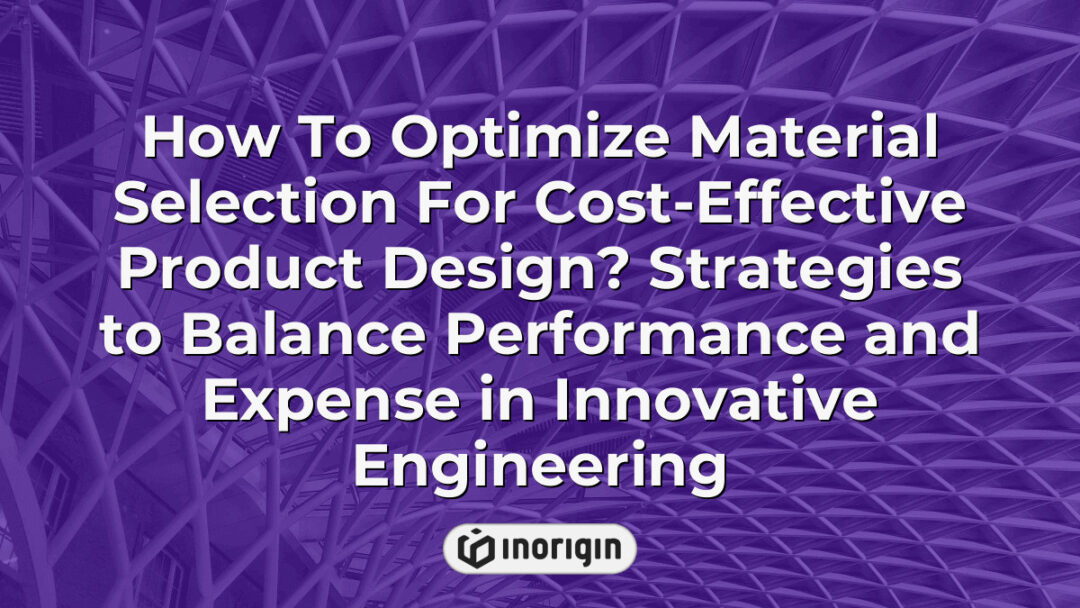Have you ever marveled at the sleek design of a high-end product and wondered how it was made so cost-effectively? Material selection is the key to achieving both aesthetic appeal and affordability in product design. Just like choosing the right ingredients for a delicious recipe, selecting the optimal materials for your products can make all the difference. In fact, studies show that up to 80% of a product’s environmental impact is determined by its material choices. So, whether you’re designing a new smartphone or a piece of furniture, learning how to optimize material selection can not only save you money but also reduce your carbon footprint. Let’s dive into how strategic material selection can unlock the perfect balance between quality and cost in product design.
| Aspect | Key Takeaway |
|---|---|
| Focus Keyword Overview | How to optimize material selection for cost-effective product design involves balancing cost, durability, and sustainability to create high-performing, budget-friendly products. |
| Impact on Product Cost | Material choices significantly influence manufacturing, transportation, and disposal costs, making informed selection critical for cost control. |
| Key Selection Factors | Evaluate lifecycle costs, material availability, production efficiency, and environmental impact to ensure economically viable material choices. |
| Performance Optimization | Prioritize materials that deliver high functionality and durability while maintaining affordability to maximize product performance and lifespan. |
| Supplier Collaboration | Partnering with suppliers can uncover cost-saving opportunities such as bulk purchasing and alternative materials without compromising quality. |
| Manufacturing Compatibility | Choosing materials compatible with existing processes minimizes additional costs related to equipment adjustments or retooling. |
| Environmental Considerations | Incorporating sustainable materials reduces environmental impact and enhances product appeal among eco-conscious consumers. |
Understanding The Impact Of Material Selection On Product Cost
When designing a product, the selection of materials has a significant impact on the overall cost. Understanding how material selection affects product cost is essential for creating a cost-effective design. The choice of materials can directly influence manufacturing costs, transportation expenses, and even the end-of-life disposal fees. Therefore, it is crucial to consider factors such as material availability, production efficiency, and environmental sustainability when making decisions about which materials to use in the design process. By analyzing these aspects carefully, designers can make informed choices that will ultimately lead to more economical product designs.
As we delve into the various factors influencing material selection for cost-effective product design, it becomes clear that understanding the impact of material selection on product cost is just one piece of the puzzle. There are several other important considerations to take into account when aiming for an optimized and budget-friendly design solution.
Factors To Consider When Selecting Materials For Cost-effective Product Design
When it comes to selecting materials for cost-effective product design, there are several factors to consider. Firstly, the overall lifecycle cost of the material should be evaluated, including its initial cost, maintenance requirements, and potential impact on production efficiency. Additionally, the availability and sourcing of the material can significantly affect its cost-effectiveness, as well as its environmental impact. Furthermore, considering the compatibility of the material with existing manufacturing processes or equipment is crucial in minimizing additional costs associated with retooling or process adjustments.
As we delve into strategies for optimizing material selection to minimize costs and maximize performance, it’s important to keep in mind that these factors will play a significant role in determining which materials are most suitable for achieving cost-effective product design.
Strategies For Optimizing Material Selection To Minimize Costs And Maximize Performance
When it comes to cost-effective product design, optimizing material selection is crucial. By selecting the right materials, you can minimize costs and maximize performance simultaneously. One strategy for achieving this balance is to prioritize materials that offer high functionality at a lower cost. Additionally, considering the long-term durability and sustainability of materials can also contribute to overall cost-effectiveness. Another key aspect is to collaborate closely with suppliers to explore options for bulk purchasing or alternative materials that may be more economical without sacrificing quality.
In conclusion, finding the optimal balance between cost and performance in material selection requires careful consideration of various factors such as functionality, durability, sustainability, and supplier collaboration. By implementing these strategies, businesses can ensure that their products are not only cost-effective but also meet the necessary performance standards.
Conclusion
In conclusion, when it comes to optimizing material selection for cost-effective product design, considering the impact of materials on overall costs is crucial. By carefully considering factors such as durability and availability, designers can develop strategies to minimize expenses while maximizing performance. It’s important to remember that thoughtful material selection can lead to substantial savings in the long run.
Related posts:
- How Can Material Selection Impact Product Cost in Precision Engineering and Design
- How Can Material Selection Impact Product Design Success Through Performance, Cost, and Innovation Integration
- How Can Sustainability Impact Material Selection in Product Design Through Lifecycle and Ethical Considerations
- How Can Material Selection Impact Your Product Design in Enhancing Performance and Sustainability at Inorigin
- Why Is Material Selection Crucial in Product Design for Enhancing Durability and User Experience
- Why Should You Consider Sustainability in Material Selection for Product Design? Driving Innovation and Market Leadership Through Eco-Conscious Choices




